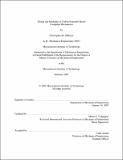| dc.contributor.advisor | Martin L. Culpepper. | en_US |
| dc.contributor.author | DiBiasio, Christopher M. (Christopher Michael) | en_US |
| dc.contributor.other | Massachusetts Institute of Technology. Dept. of Mechanical Engineering. | en_US |
| dc.date.accessioned | 2007-08-29T19:08:07Z | |
| dc.date.available | 2007-08-29T19:08:07Z | |
| dc.date.copyright | 2007 | en_US |
| dc.date.issued | 2007 | en_US |
| dc.identifier.uri | http://hdl.handle.net/1721.1/38544 | |
| dc.description | Thesis (S.M.)--Massachusetts Institute of Technology, Dept. of Mechanical Engineering, 2007. | en_US |
| dc.description | This electronic version was submitted by the student author. The certified thesis is available in the Institute Archives and Special Collections. | en_US |
| dc.description | Page 110 blank. | en_US |
| dc.description | Includes bibliographical references (p. 97-100). | en_US |
| dc.description.abstract | The objective of this research is to generate the knowledge required to adapt macro- and microscale compliant mechanism theory to design carbon nanotube-based nano-scale compliant mechanisms. Molecular simulations of a nano-scale parallel guiding mechanism uncovered three regions of behavior. Region I is governed by the bulk deformation of the carbon nanotubes. Region II is characterized by hinge-like flexing of four "kinks" that occur due to buckling of the carbon nanotube walls. Region III, an intermediate region, exhibits direction dependant behavior. We report on the ability of a conventional compliant mechanism modeling approach, the pseudo-rigid-body model, to predict the region I behavior of a nano-scale parallel guiding mechanism that uses single-walled (5,5) carbon nanotubes as the flexural elements. Van der Waals forces were found to affect the kinematic and elastomechanic behavior of the nano-scale parallel guiding mechanism. A modified value of the pseudo-rigid-body model stiffness coefficient is presented to capture the affect of van der Waals interactions within (5,5) nanotubes during region I operation. | en_US |
| dc.description.abstract | (cont.) Molecular simulation of region I behaviors match the modified pseudo-rigid-body model predictions of (1) kinematic behavior with less than 7.3 % error and (2) elastomechanic behavior with less than 8 % error. Although region I is of the most interest because of its well-defined and stable nature, region II motion is also investigated to provide a basis for establishing future work in this region. | en_US |
| dc.description.statementofresponsibility | by Christopher M. DiBiasio. | en_US |
| dc.format.extent | 110 p. | en_US |
| dc.language.iso | eng | en_US |
| dc.publisher | Massachusetts Institute of Technology | en_US |
| dc.rights | M.I.T. theses are protected by copyright. They may be viewed from this source for any purpose, but reproduction or distribution in any format is prohibited without written permission. See provided URL for inquiries about permission. | en_US |
| dc.rights.uri | http://dspace.mit.edu/handle/1721.1/7582 | |
| dc.subject | Mechanical Engineering. | en_US |
| dc.title | Design and modeling of carbon nanotube-based compliant mechanisms | en_US |
| dc.type | Thesis | en_US |
| dc.description.degree | S.M. | en_US |
| dc.contributor.department | Massachusetts Institute of Technology. Department of Mechanical Engineering | |
| dc.identifier.oclc | 166145701 | en_US |
